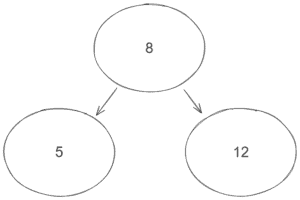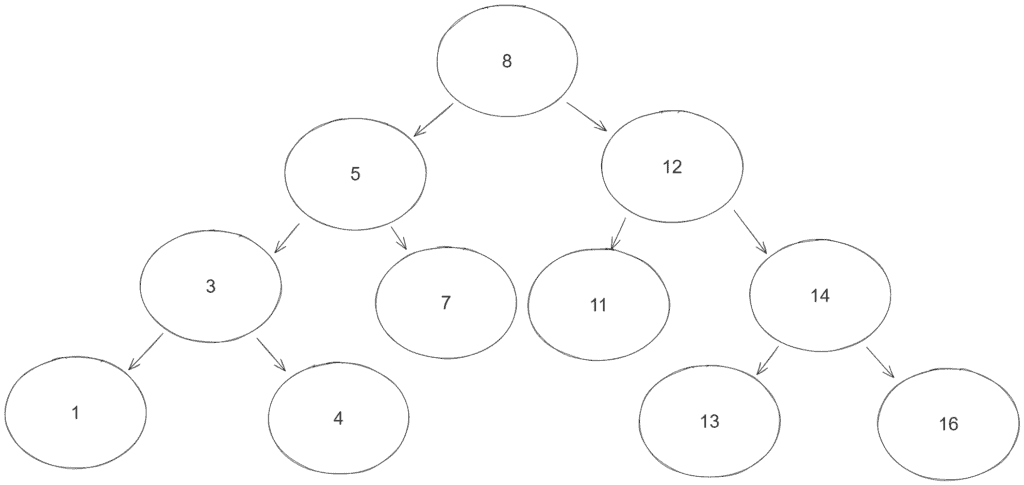1. 引言
二叉搜索树(BST)是一种高效解决实际问题的数据结构。本文将探讨如何在BST中查找任意节点的父节点,并提供多种实现方案。
2. 什么是二叉搜索树?
BST是一种每个节点最多指向两个子节点(左子节点和右子节点)的树结构,且每个节点的值大于其左子节点、小于其右子节点。
例如,三个节点A=2、B=1、C=4可以构成一个BST:A作为根节点,B作为左子节点,C作为右子节点。后续我们将使用带有默认insert()方法的BST实现来演示查找父节点的问题。
3. 二叉搜索树中的节点父节点问题
3.1. 问题描述
BST中的节点包含指向左右子节点的指针。以一个简单BST为例:

节点8有两个子节点5和12,因此节点8是5和12的父节点。
核心问题:给定任意节点值,找到其父节点。 即查找某个子节点值等于目标值的节点。例如:
- 输入5 → 输出8
- 输入12 → 输出8
⚠️ 边界情况:
- 查找根节点(无父节点)
- 查找不存在的节点(无父节点)
3.2. 测试结构
在深入解决方案前,先定义基础测试结构:
class BinaryTreeParentNodeFinderUnitTest {
TreeNode subject;
@BeforeEach
void setUp() {
subject = new TreeNode(8);
subject.insert(5);
subject.insert(12);
subject.insert(3);
subject.insert(7);
subject.insert(1);
subject.insert(4);
subject.insert(11);
subject.insert(14);
subject.insert(13);
subject.insert(16);
}
}
setUp()方法构建如下BST:

4. 递归解决方案
最直观的方案是递归遍历树,当发现当前节点的子节点等于目标值时立即返回当前节点。
首先在TreeNode类中定义公共方法:
TreeNode parent(int target) throws NoSuchElementException {
return parent(this, new TreeNode(target));
}
递归核心实现:
TreeNode parent(TreeNode current, TreeNode target) throws NoSuchElementException {
if (target.equals(current) || current == null) {
throw new NoSuchElementException(format("No parent node found for 'target.value=%s' " +
"The target is not in the tree or the target is the topmost root node.",
target.value));
}
if (target.equals(current.left) || target.equals(current.right)) {
return current;
}
return parent(target.value < current.value ? current.left : current.right, target);
}
算法逻辑:
- 边界检查:若当前节点是根节点或节点不存在,抛出异常
- 匹配检查:若当前节点的子节点匹配目标值,返回当前节点
- 递归遍历:根据目标值大小选择左/右子树递归
✅ 测试验证:
@Test
void givenBinaryTree_whenFindParentNode_thenReturnCorrectParentNode() {
assertThrows(NoSuchElementException.class, () -> subject.parent(1231)); // 不存在节点
assertThrows(NoSuchElementException.class, () -> subject.parent(8)); // 根节点
assertEquals(8, subject.parent(5).value); // 5的父节点是8
assertEquals(5, subject.parent(3).value); // 3的父节点是5
assertEquals(5, subject.parent(7).value); // 7的父节点是5
assertEquals(3, subject.parent(4).value); // 4的父节点是3
// 其他节点测试...
}
复杂度分析:
- 时间:最坏O(n)(退化为链表),平衡树O(log n)
- 空间:O(h)(h为树高,递归调用栈深度)
5. 迭代解决方案
递归方案通常可转为迭代实现,这里用栈和while循环替代递归。
在TreeNode类中添加接口方法:
TreeNode iterativeParent(int target) {
return iterativeParent(this, new TreeNode(target));
}
核心迭代实现:
TreeNode iterativeParent(TreeNode current, TreeNode target) {
Deque<TreeNode> parentCandidates = new LinkedList<>();
String notFoundMessage = format("No parent node found for 'target.value=%s' " +
"The target is not in the tree or the target is the topmost root node.",
target.value);
if (target.equals(current)) {
throw new NoSuchElementException(notFoundMessage);
}
while (current != null || !parentCandidates.isEmpty()) {
// 左子节点遍历
while (current != null) {
parentCandidates.addFirst(current);
current = current.left;
}
current = parentCandidates.pollFirst();
// 检查是否为父节点
if (target.equals(current.left) || target.equals(current.right)) {
return current;
}
current = current.right; // 转向右子树
}
throw new NoSuchElementException(notFoundMessage);
}
算法四步走:
- 外层循环:继续遍历直到处理完所有节点
- 内层循环:沿左子树向下,将候选父节点压栈
- 节点检查:弹出栈顶节点,检查是否为目标父节点
- 右子树处理:若未找到则转向右子树
✅ 测试验证:
@Test
void givenBinaryTree_whenFindParentNodeIteratively_thenReturnCorrectParentNode() {
assertThrows(NoSuchElementException.class, () -> subject.iterativeParent(1231));
assertThrows(NoSuchElementException.class, () -> subject.iterativeParent(8));
assertEquals(8, subject.iterativeParent(5).value);
assertEquals(5, subject.iterativeParent(3).value);
assertEquals(5, subject.iterativeParent(7).value);
assertEquals(3, subject.iterativeParent(4).value);
// 其他节点测试...
}
复杂度分析:
- 时间:最坏O(n),平衡树O(log n)
- 空间:O(h)(栈存储候选父节点)
6. 带父指针的BST实现
终极方案:修改BST结构,在节点中直接存储父节点引用。
创建新类ParentKeeperTreeNode:
class ParentKeeperTreeNode {
int value;
ParentKeeperTreeNode parent; // 新增父节点引用
ParentKeeperTreeNode left;
ParentKeeperTreeNode right;
// 构造方法、equals和hashCode...
}
自定义insert()方法维护父指针:
void insert(ParentKeeperTreeNode currentNode, final int value) {
if (currentNode.left == null && value < currentNode.value) {
currentNode.left = new ParentKeeperTreeNode(value);
currentNode.left.parent = currentNode; // 设置父节点
return;
}
if (currentNode.right == null && value > currentNode.value) {
currentNode.right = new ParentKeeperTreeNode(value);
currentNode.right.parent = currentNode; // 设置父节点
return;
}
if (value > currentNode.value) {
insert(currentNode.right, value);
}
if (value < currentNode.value) {
insert(currentNode.left, value);
}
}
关键点:创建新子节点时,将当前节点设为其父节点。
✅ 测试验证:
@Test
void givenParentKeeperBinaryTree_whenGetParent_thenReturnCorrectParent() {
ParentKeeperTreeNode subject = new ParentKeeperTreeNode(8);
subject.insert(5);
subject.insert(12);
subject.insert(3);
// 插入其他节点...
assertNull(subject.parent); // 根节点无父节点
assertEquals(8, subject.left.parent.value); // 5的父节点是8
assertEquals(8, subject.right.parent.value); // 12的父节点是8
assertEquals(5, subject.left.left.parent.value); // 3的父节点是5
// 其他节点测试...
}
优势分析:
- 时间复杂度:O(1)(直接访问父节点引用)
- 空间复杂度:O(1)(仅需存储一个引用)
- ✅ 适用场景:频繁需要获取父节点的操作
7. 总结
本文探讨了BST中查找父节点的三种实现方案:
- 递归方案:代码简洁,但受递归深度限制
- 迭代方案:避免递归栈溢出,逻辑稍复杂
- 父指针方案:空间换时间,适合高频查询场景
💡 踩坑提示:递归方案在树退化时可能导致栈溢出,生产环境建议用迭代方案;若父节点查询极其频繁,重构数据结构可能是更优解。
完整代码示例可在GitHub仓库获取。